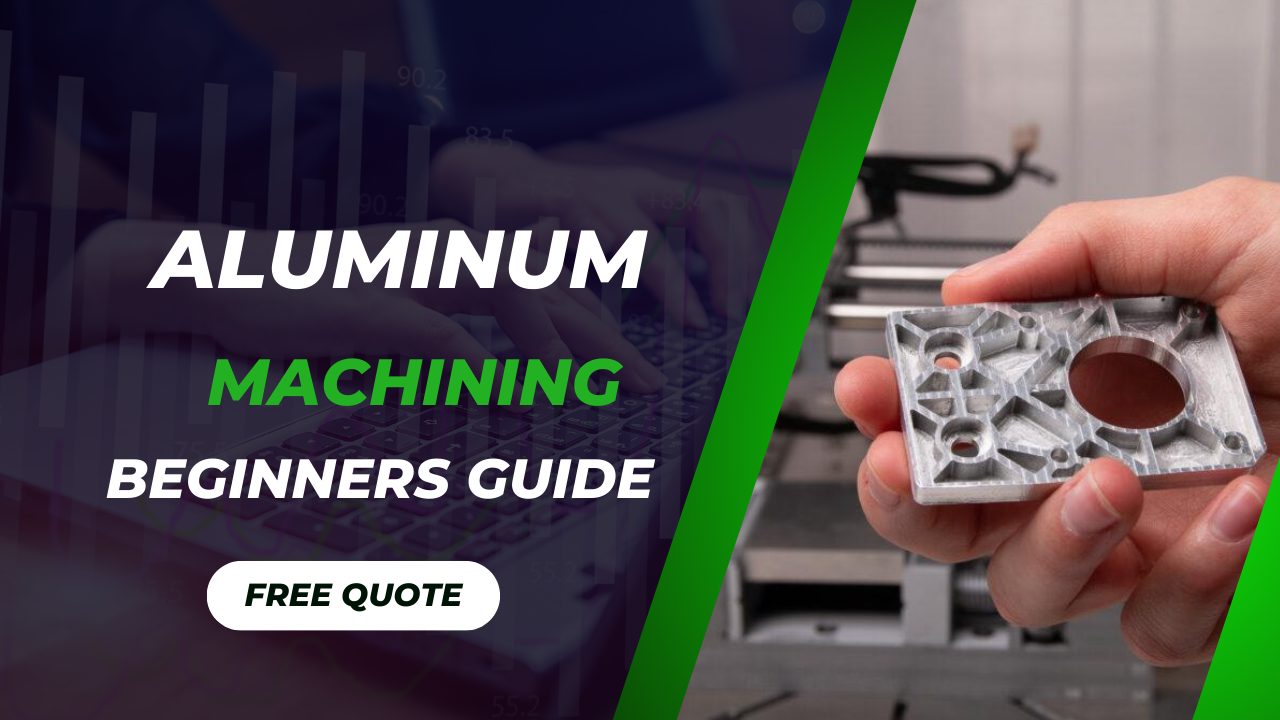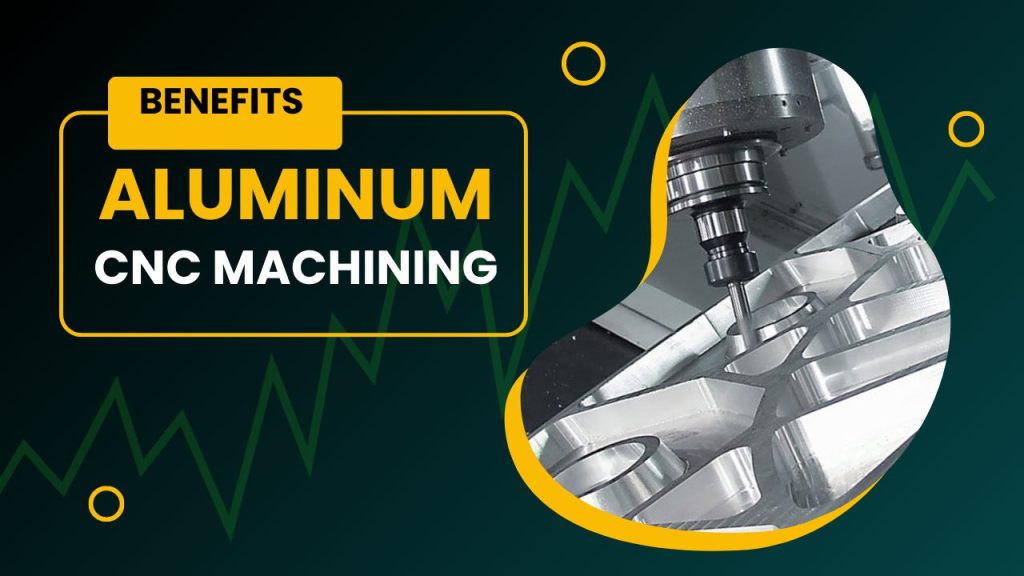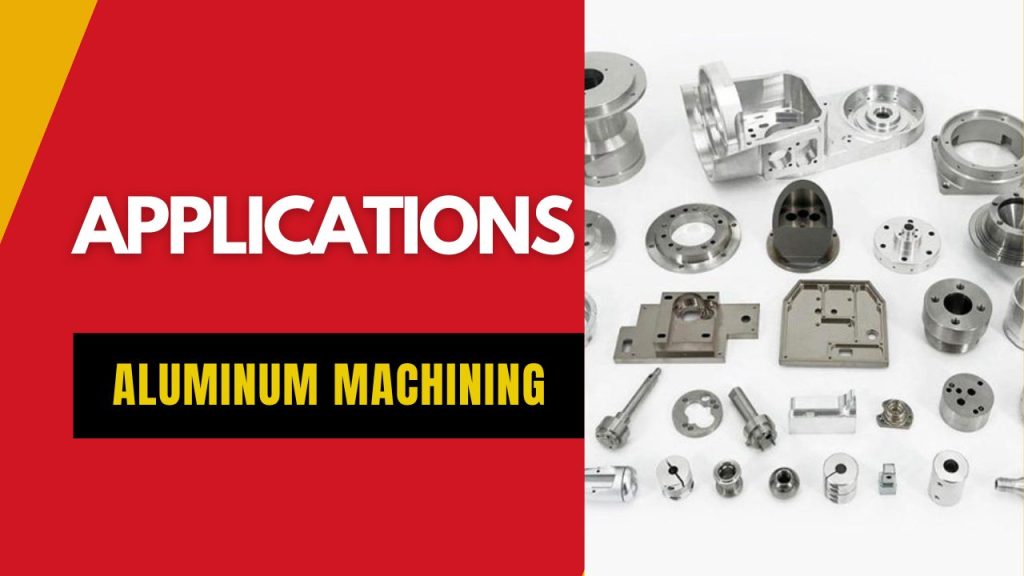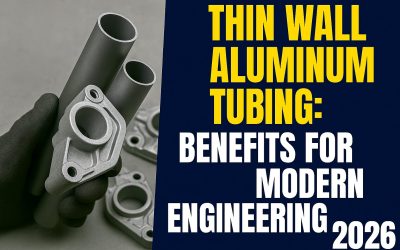Have you ever wondered how those sleek aluminum parts in your gadgets or vehicles come to life? It’s all thanks to a fascinating process called aluminum machining cnc, where precision meets practicality.
In particular, aluminum is a highly-valued non-ferrous metal and is ideal for numerous industries. That provides good protection against corrosion, incredible durability, and lightweight properties.
The relevance of CNC machining in manufacturing has revolutionized production techniques, leveraging loT and AI to enhance operational efficiency by 25%. That brings designs to life with pinpoint accuracy and provides precise, repeatable processes. With aluminum, it becomes even more effective, enabling the efficient production of complex, durable parts.
In this article, we’ll explore everything about aluminum CNC machining. From its basics to its benefits, challenges, applications, costs, and material selection, we’ll cover it all. Buckle up!
Understanding Aluminum CNC Machining
What is aluminum CNC machining?
Aluminum alloys are commonly used in multiple industries, offering versatile properties for different purposes, such as being soft, non-metallic, and ductile in their purest forms. It involves using computer-controlled machines to shape aluminum parts and alloy them with various elements. That may include magnesium, copper, and manganese, to create different alloys with varyingly improved properties.
Aluminum CNC machining is a popular machining operation, reflecting the frequency of execution due to its remarkable machinability. It allows the manufacturers to make different precision aluminum parts that meet the intended applications’ requirements. This process ensures high precision and consistency in producing intricate designs into preferred shapes and dimensions.
Brief History and Evolution of Aluminum CNC Machining
Back in the 1940s and 1950s, the first NC machine was introduced based on the existing tools that were modified with motors. However, CNC machining has come a long way since manufacturers used manual tools, requiring a lot of skills and time.
CNC machining has transformed the manufacturing process and has expanded its capabilities with the help of advanced technology. It makes it easier for manufacturers to produce more accurate parts for simple tasks, allowing them to handle complex designs.
Benefits of Aluminum in CNC Machining
- Strength and Weight Ratio
- Machinability
- Protection against corrosion
- Electrical Conductivity
- Custom Finishing
- Recyclability
Strength and Weight Ratio
Aluminum alloys offer high strength while being lightweight. It is used in applications requiring durability and where weight is a concern, like the automotive and aerospace sectors.
Machinability
Aluminum material is easy to machine, reducing wear and tear on tools. The entirety of manufacturers rely on them, as they offer faster production times and lower costs.
Protection against corrosion
This metal possesses excellent protection against corrosion to rust, making it the perfect material selection for outdoor applications and environments exposed to moisture.
Electrical Conductivity
Aluminum metal enables applications to run smoothly, as its conductivity makes it a go-to material for electrical components and systems.
Custom Finishing
Whether you want it glossy or matte, it can be anodized, polished, or painted, offering you unlimited customization options.
Recyclability
Aluminum parts provide 100% recyclable options for manufacturers. That helps reduce the carbon footprint on the environment.
Aluminum Grades for CNC Machining
Common Alloying Elements
The aluminum parts for the CNC machining process can be mixed with several varieties of alloys, including zinc, silicon, magnesium, manganese, and copper. Each material adds special elements to enrich the application’s performance. Such as magnesium increases machineability, zinc improves strength, silicon boosts fluidity, manganese enhances resistance to wear, and copper enhances hardiness.
Impact of Alloying Elements
The combinations of various alloys can tweak aluminum‘s properties, making it stronger, more heat resistant, or simpler to handle. For instance, the utilization of copper alloys to increase aluminum strength can reduce protection against corrosion. Therefore, a proper understanding of these impacts enables manufacturers to choose the right components for their specific requirements.
Aluminum Grade Series
|
Series |
Alloying Element |
Characteristics |
Typical Applications |
|
1000 |
Pure Aluminum |
Excellent protection against corrosion, high thermal & electrical conductivity, low strength |
Electrical conductors, chemical equipment, and the food industry |
|
2000 |
Copper |
High strength, poor protection against corrosion, and good machinability |
Aerospace components, military applications, and automotive parts |
|
3000 |
Manganese |
Good protection against corrosion, moderate strength, and good formability |
Beverage cans, roofing sheets, and chemical equipment |
|
4000 |
Silicon |
Good wear resistance, moderate strength, and improved fluidity in casting |
Welding wire, brazing, automotive components |
|
5000 |
Magnesium |
Excellent protection against corrosion, good weldability, moderate to high strength |
Marine applications, pressure vessels, automotive body panels |
|
6000 |
Magnesium and Silicon |
Have excellent mechanical properties, good protection against corrosion, and machinability |
Structural components, frames, pipelines, and automotive parts |
|
7000 |
Zinc |
Very high strength, less protection against corrosion, good machinability |
Aerospace structures, military applications, and sports equipment |
|
8000 |
Other Elements |
Enhanced properties based on specific elements (e.g., lithium for reduced density) |
Specialized aerospace applications, packaging |
Common Aluminum CNC Machining Techniques
CNC machining involves several key processes to shape aluminum into precise components, and the basic techniques may include:
- Milling
- Drilling
- Turning
CNC Milling
In the milling technique, rotary cutters are used to remove materials from the workpiece. That enables the manufacturers to produce complex shapes and intricate designs like gears, brackets, and enclosures. This process can handle a variety of tough tasks, from simple cuts to detailed carvings.
CNC Drilling
Drilling is the go-to process that helps create a hole. Aluminum’s machinability makes drilling a breeze, allowing precise holes without excessive tool wear. This step is essential in aluminum CNC machining, whether it’s for screw threads or pathways for wiring.
CNC Turning
Picture shaping a piece of clay on a potter’s wheel. Similarly, in the turning process, the workpiece rotates while a stationary cutting tool shapes it. It can create cylindrical parts and achieve smooth, precise finishes for shafts, cylinders, and bolts.
Key Challenges in Aluminum CNC Machining
Product engineers and manufacturing companies often face challenges in aluminum CNC machining, regardless of its remarkable machinability. Let’s discuss some of these challenges along with possible solutions:
- Aluminum’s Malleability
- Thermal Issues During Machining
- Wear and Tear of Machining Tools
Aluminum’s Malleability
Aluminum’s softness can lead to issues like poor surface finish and burrs. Buit-up edges frequently happen as the material sticks to the cutting tool, which ultimately results in reduced tool life.
Solutions:
1. Use Sharp tools
Sharp cutting tools reduce the risk of creating burrs and help achieve a smoother surface finish.
2. Proper Cutting Fluids
Utilizing appropriate cutting fluids can minimize friction and heat, improving the finish.
3. Secure Workpieces Properly
Make sure the workpiece is properly clamped, reducing vibration to achieve a better surface finish
Thermal Issues During Machining
Aluminum conducts heat well, which can affect accuracy. This may result in workpiece thermal deformations, low machining accuracy, and tool wear.
Solutions:
High-Pressure Coolant Systems
Using high-pressure coolant systems helps dissipate heat efficiently.
Adjust Cutting Speeds
Fine-tuning cutting speeds and feed rates can minimize heat buildup.
Proper Tool Selection
Choosing tools designed for materials with high thermal conductivity ensures better performance.
Wear and Tear of Machining Tools
Aluminum CNC machining can be abrasive due to the presence of silicon in it. This challenge leads to rapid tool wear and consistent tool changes during aluminum CNC machining.
Solutions:
High-Quality Tools
Using high-quality, durable tools can withstand the abrasiveness of aluminum alloys.
Tool Coatings
To enhance the wear resistance of applications, manufacturers can apply coatings like titanium nitride.
Regular Checks and Maintenance
Frequent inspections and maintenance of tools ensure longevity and consistent performance.
Applications of Aluminum CNC Machined Parts
The practical applications and benefits of aluminum CNC machining pack outstanding qualities ideal for different industries and purposes. The following are a few typical applications of these machined parts:
Aerospace Industry
Specifically, aerospace employs aluminum CNC machined parts to promote the use of lightweight structural components, including landing gears, engines, and airframes. They are relatively lighter in weight and possess a good strength-to-weight ratio coupled with respectable mechanical characteristics.
They support the aerospace industry’s need for precision and reliability. It’s key to making aerostructures like fuselage sections and wing panels.
Automotive Industry
The automotive industry has been enriched by the excellent properties of aluminum when manufacturing numerous auto parts and mechanisms. Manufacturers use aluminum CNC machined parts in automotive engineering, most especially in engine components, suspension systems, transmission housings, and electric vehicle components.
The lightweight, durability, and strength of aluminum alloys make CNC-machined aluminum parts perfect for decreasing overall vehicle weight while ensuring the reliability of vehicles.
Consumer Electronics
Aluminum CNC machined parts are extensively used to manufacture diverse and interconnected consumer electronics products, including laptops, audio devices, smartphones and tablet computers, and camera parts. Employing aluminum for laptop casings, smartphones, and tablets provides smoothness when designing the outer cover. It offers a lightweight construction that guards the various sensitive parts of electronic devices.
In addition, high-end amplifiers, headphones, speakers, and enclosures often have aluminum parts that are CNC machined. Aluminum is usually used in this application because it is a good absorber of vibration. Aluminum CNC machined parts also provide the requisite strength and can also expel heat in other devices, such as cameras.
Cost of Aluminum CNC Machining
When considering aluminum CNC machining, various factors influence the overall cost. Understanding these can help manage budgets and optimize production processes.
Factors Affecting Costs
- Raw Material Prices
- Machining Hours
- Labor Costs
- Tool Wear and Tear
- Product Complexity
Raw Material Prices
The cost of aluminum can vary based on market conditions. Specialized alloys or higher-purity aluminum might increase expenses.
Machining Hours
The complexity of the intricate appearances directly impacts the machining time. More intricate designs require more precision and time, driving up the cost.
Labor Costs
Skilled labor is essential for operating CNC machines and ensuring high-quality outputs. Higher labor costs can significantly influence the total expenses.
Tool Wear and Tear
Machining aluminum, particularly harder alloys, can wear down tools quickly. Frequent tool replacements and maintenance add to the overall cost.
Product Complexity
Complex parts with tight tolerances require more meticulous machining, increasing both time and labor costs.
Cost Comparison with Other Metals
Aluminum CNC machining offers several cost advantages over other metals, particularly steel. It includes the following major aspects:
- Raw material Costs
- Machining Efficiency
- Tool Wear and Energy Consumption
Raw Material Costs
Aluminum’s raw material costs are typically lower than the cost of steel specified for large-volume production, which is reflected in the overall price. Its lower density means you get more material per pound.
Machining Efficiency
Aluminum is softer, facilitating the process of machining, which takes only 1/2 to 1/4 the time required for steel parts, which reduces machining time and tool wear. This efficiency translates into lower production costs.
Tool Wear and Energy Consumption
Aluminum’s machinability minimizes tool wear and energy consumption, making it a more economical choice over the long term.
How to Choose the Right Partner for Aluminum CNC Machining
Aluminum offers many desirable benefits and properties with CNC machining. However, selecting the right manufacturing partner to handle your aluminum CNC machining project with assurance of quality and efficiency is essential.
Essential Criteria
- Right Machining Tools
- Experience in Manufacturing Aluminum Parts
- Required Quality Certifications
Right Machining Tools
Ensure your partner has the latest CNC machinery and tools specifically designed for aluminum machining. Modern equipment can handle the material’s unique properties, leading to better results.
Experience in Manufacturing Aluminum Parts
The manufacturers must have experience manufacturing aluminum parts and all the required quality certifications, which will help you get valuable insights and efficient solutions.
Required Quality Certifications
CNC machining experts and their team of machinists and engineers should have certifications like ISO 9001. That ensures the company adheres to stringent quality standards. These certifications assure high-quality output and consistent performance.
What to Avoid
- CNC Machine Shops Without Necessary Certifications
- Partners with Little or No Experience in Aluminum CNC Machining
CNC Machine Shops Without Necessary Certifications
Avoid partners who lack quality certifications. This might indicate a lack of adherence to industry standards, leading to subpar results.
Partners with Little or No Experience in Aluminum CNC Machining
Experience matters. Partners unfamiliar with aluminum may struggle with its unique properties, resulting in inferior products and increased costs.
Conclusion:
Aluminum CNC machining is an important advancement for modern manufacturing regarding efficiency, cost-effectiveness, and versatility. It provides a great strength-to-weight ratio and offers ease of machining. Businesses can truly harness technology by understanding the comprehensive guide to what drives costs and picking the right partner. This approach guarantees top-notch results, smooth production processes, and wise resource use.
Therefore, selecting a reliable partner and getting a handle on cost drivers are the necessary steps. That allows you to team up with seasoned and certified CNC machining experts. So that you can confidently achieve the possible outcomes for your projects.








0 Comments